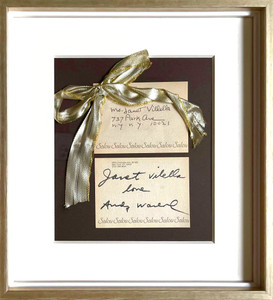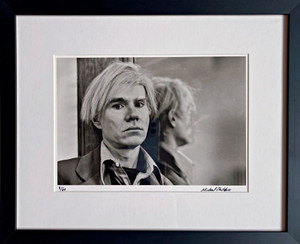
Andy Warhol
Marcel Proust, ca. 1976
Acetate positive acquired directly from Chromacomp, Inc. Andy Warhol's printer in the 1970s. Accompanied by a Letter of Provenance and Authenticity from the representative of Chromacomp
Accompanied by Letter of Provenance from the representative of Chromacomp, Andy Warhol's printer
Frame included
Elegantly framed in a museum quality wood frame with UV plexiglass.
Measurements:
Frame:
17.75 x 14.75 x 1.5 inches
Photograph:
10.75 x 7.75 inches
This unique photographic positive acetate is of the 19th and early 20th century French novelist Marcel Proust, who's chef d'oeuvre A la recherche du temps perdu inspired some Warhol titles.
Warhol would transfer the acetate to a transparency, allowing an image to be magnified and projected onto a screen. Warhol created a silkscreen painting of Marcel Proust and sent this acetate to his printer, Chromacomp, Inc. for consideration as a silkscreen multiple, which was never made.
This acetate was brought by Warhol to Eunice and Jackson Lowell, owners of Chromacomp,Inc. a fine art printing studio in New York City. During the 1970s and 1980s, it was the premier atelier for fine art limited edition silkscreen prints; indeed, Chromacomp was the largest studio producing fine art prints in the world for artists such as Andy Warhol, Leroy Neiman, Erte, Robert Natkin, Larry Zox, David Hockney and many more. All of the plates were done by hand and in some cases photographically.
Warhol had considered creating limited edition prints with Chromacomp of his famous portrait of Proust based upon this photographic image. The original painting was commissioned by art dealer Marie-Louise Jeanneret for a group of Italian collectors and avid Proust enthusiasts, Warhol's original four acrylic and silkscreen ink on linen works were based on a famous 1895 photograph of the French novelist captured by Otto Wegener.
Marcel Proust, the distinguished French novelist, literary critic, and essayist, achieved renowned for his monumental 1908 seven-volume novel In Search of Lost Time. The literary masterpiece delved into the intricacies of memory, time and the profound complexity of the human experience. Proust's literary genius revolutionized the landscape of literature, leaving an enduring impact on the Parisian cultural scene at the turn of the century. About 50 years later, Andy Warhol emerged as a visionary artist who challenged artistic conventions, exploring themes that resonated with Proust's own ideas. Warhol, a trailblazer in his own right, delved into philosophical reflections on consumerism, mass production and the nature of fame. His artistic endeavors mirrored Proust's explorations, albeit through a contemporary lens, as he sought to redefine the boundaries of art and popular culture.
About Andy Warhol:
Isn’t life a series of images that change as they repeat themselves?
—Andy Warhol
Andy Warhol’s (1928–1987) art encapsulates the 1960s through the 1980s in New York. By imitating the familiar aesthetics of mass media, advertising, and celebrity culture, Warhol blurred the boundaries between his work and the world that inspired it, producing images that have become as pervasive as their sources.
Warhol grew up in a working-class suburb of Pittsburgh. His parents were Slovak immigrants, and he was the only member of his family to attend college. He entered the Carnegie Institute of Technology (now Carnegie Mellon University) in 1945, where he majored in pictorial design. After graduation, he moved to New York with fellow student Philip Pearlstein and found steady work as a commercial illustrator at several magazines, including Vogue, Harper’s Bazaar, and the New Yorker. Throughout the 1950s Warhol enjoyed a successful career as a commercial artist, winning several commendations from the Art Directors Club and the American Institute of Graphic Arts. He had his first solo exhibition at the Hugo Gallery in 1952, showing drawings based on the writings of Truman Capote; three years later his work was included in a group show at the Museum of Modern Art for the first time.
The year 1960 marked a turning point in Warhol’s prolific career. He painted his first works based on comics and advertisements, enlarging and transferring the source images onto canvas using a projector. In 1961 Warhol showed these hand-painted works, including Little King (1961) and Saturday’s Popeye (1961), in a window display at the department store Bonwit Teller; in 1962 he painted his famous Campbell’s Soup Cans, thirty-two separate canvases, each depicting a canned soup of a different flavor. Soon after, Warhol began to borrow not only the subject matter of printed media, but the technology as well. Incorporating the silkscreen technique, he created grids of stamps, Coca-Cola bottles, shipping and handling labels, dollar bills, coffee labels, and more, breaking down the images to their basic graphic components.
In 1963 Warhol established a studio on East 47th Street, which became known as the Factory and served as a cultural hub for artists, models, performers, and socialites. His inner circle comprised his Superstars, who played a major role in both his work and his social life. Interested in the production of fame, Warhol began to screen-print images of celebrities and public figures, from Marilyn Monroe and Elvis Presley to Jackie Kennedy and Mao Zedong. Expanding his practice, as well as his cultural influence, he produced records (The Velvet Underground & Nico), started a magazine (Interview), and made avant-garde films, such as Chelsea Girls (1966), Blow Job (1964), and Empire (1964), which have become classics of the underground genre.
Following a close run-in with death when Valerie Solanas shot him in 1968, Warhol entered a more subdued, isolated period, working primarily on a commissioned basis and painting portraits for various patrons, while also revisiting themes from his earlier work. He then began to pursue a new interest in abstraction, first with his Oxidations (1977–78), made by allowing friends and acquaintances to urinate on canvases painted with metallic pigments, and later with his Rorschach (1984) and Camouflage (1986) paintings.
By the early 1980s Warhol was producing work across media with a renewed vigor, hosting half-hour programs on MTV, publishing books, and collaborating with younger artists including Jean-Michel Basquiat, Francesco Clemente, and Keith Haring. His abstract series coincided with large-scale works that looked back at masterpieces by Leonardo da Vinci: he screen-printed images of the Mona Lisa (1503) and created several monumental canvases of The Last Supper (1495–98). Warhol’s ability to seamlessly combine art historical reference, abstract patterns, and mass media set new standards for the role of the artist, permanently blurring the lines between commercial and fine art.
Courtesy of Gagosian Gallery
About Marcel Proust:
Marcel Proust was born on July 10, 1871 in the Paris suburb of Auteuil. His father, Dr. Adrien Proust, was one of France's most distinguished scientists. His mother, Jeanne Weil, was a well-educated woman who loved the great classic writers of the 17th century, especially Molière and Racine. Marcel's only sibling, Robert, was born in 1873. The hypersensitive Marcel suffered all his life from a number of ailments, especially asthma. Although he earned university degrees in philosophy and law, he always knew that he wanted to be a writer.
In 1910, he had his bedroom lined with cork to block out the deafening noise of daytime Paris because he slept during the day and wrote through the night, after returning home from some of Paris's most exclusive salons. He was known as the city's most famous recluse, he even called himself an owl because he wrote while listening to his “nocturnal Muse.” Swann’s Way, the first volume of In Search of Lost Time, was published in November 1913 and was headed for a fourth printing when World War I broke out.
Proust continued to write, incorporating the unprecedented conflict into his story of contemporary French society. In 1919, Within a Budding Grove was published and won the Prix Goncourt, France's most prestigious literary prize. The final three years of his life saw the publication of The Guermantes Way and Sodom and Gomorrah. The Captive, The Fugitive, and Time Regained were published posthumously. The novel's main themes are time and memory and the power of art to withstand the destructive forces of time.
Courtesy of Proust-ink








